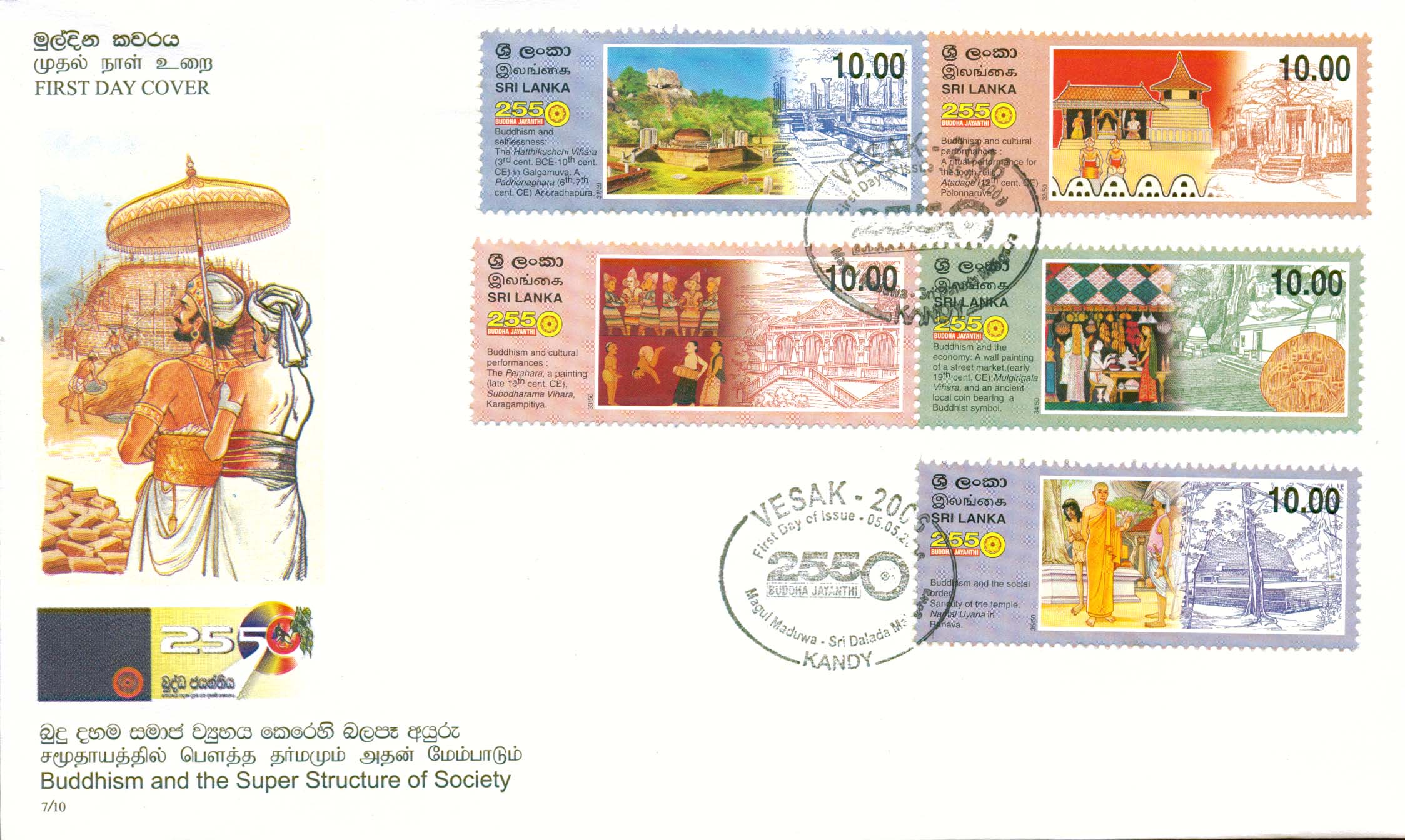| Stamp Bulletin No. 609
| Commemorative Issue |
2550 Years of Buddhist Era - 2006
2006.05.05
Philatelic Bureau
Department of Posts,
Postal Headquarters, D. R. Wijewardena Mawatha, Colombo 00100, SRI LANKA
Philatelic Bureau of the Department of Posts, issued a set of 50 stamps in
the denominations of Rs. 2.50, Rs. 4.50, Rs. 5.00, Rs. 10.00,
Rs. 17.00, with 10 stamps each making up the set (10x5), on 5th. May 2006 to
commemorate Vesak 2006; the completion of 2550 years of the great
demise of Lord Buddha.
Buddhism is the major philosophical stream that has been a substantial
inspiration to shape most of the important socio-political and
cultural-economic trajectories of Sri Lankan history, as well as it
functioned in the other parts of the wider South Asian region. It was
legitimately planted on the infrastructure ofthe country in the mid
third century BCE, and since then has flourished throughout the
society as the major intellectual apparatus of the social psychic. As
historical evidence suggests, the Buddhist monasteries appeared as the
hub of linking differences of the lay society while playing an
important role in keeping the society in a state of
equilibrium. Archaeological discoveries in the country have emphasized
another dimension of practicing Buddhism in Sri Lanka, that is its
intrusion into the intangible aspects, such as social relations and
cognition of the people. More elaborate examples are the magnificent
paintings, architectural edifices, and the splendid rural agricultural
landscapes, in which Buddhist monasteries have played a key role.
This series of stamps describe various aspects of Buddhism with
special reference to its practice in Sri Lanka. The series comprises
fifty stamps divided into groups that portray ten major themes
01. Life of the Prince "Siddharttha"
02. The Buddhahood
03. Transcendental Virtues, Parami (Perfections)
04. Arrival ofBuddhism in Lanka and it's propagation
05. Indigenous developments of Buddhism in Lanka
06. Buddhist influence on society
07. Buddhism and the superstructure of society
08. Buddhist influence on architecture
09. Buddhist influence on art and sculpture
10. Buddhist Philosophy in Sri Lanka
Beyond the limits set out by each theme, the entirety of the message
carried by the current series focuses on exemplifying the universality
of the scope and the teachings ofthe great philosophy
of Buddhism Central to all, two specific aspects of the philosophical
teachings of Buddhism, Karuna (compassion) and Prajna (wisdom) come to
fore, while some expect to make Buddhism appropriate to the chaotic
modem world, which is perhaps the most frustrating era of conflict,
dissatisfaction and endless struggle for power. The eternity, the
tranquility, the agelessness and the immortality of the essence of
Buddhism are worthwhile to reiterate on the day of commemoration of
2550 year after the great dimise of the Master. This series of stamps
will recall the imperative necessity of readapting the values and
norms formulated by Buddhism to the society and it explicitly shows
how the Sri Lankan society nourished by the essence of this great
philosophy for a period of more than two and half millennia.
07. Buddhism and the superstructure of society
34. Buddhism and the Economy

A painting of the early 19th century CE from Mulgirigala Viharaya
and a depiction of an ancient local coin.
Several inscriptions at the Mulgirigala Viharaya suggest that the
Buddhist monks occupied the site since 250 BCE. A twelfth century rock
inscription at the site describes its name as Muhundgiri Viharaya. The
Katagamuva inscription of Manabharana declared a grant to a Buddhist
Vihara that bears the same name. The Muhundugiri Viharaya mentioned in
those inscriptions is identified with the Samudragiri Viharaya
constructed by King Kakavannatissa. The socio-economic interaction
between Europeans and the local communities in the southern maritime
littoral areas during the period between the eighteenth and twentieth
centuries explicitly contrasts with that of the hinterland areas of
the country. The events portrayed in the temple paintings of the
southern maritime littoral area provide us a substantial set of
information pertaining to such interactive realms especially the one,
which is associated with economic expectations.
Technical Details
| Date of Issue | 5th May 2006
|
| Denominations | Rs. 10.00
|
| Designer | 34. Mevan Fonseka
|
| Stamp Size | 60mm x 25mm
|
| Format | Horizontal
|
| Printing Process | Offset Lithography
|
| Sheet Composition |
Set I - 50 stamp in a sheet containing 50 different designs
Set III - 10 stamps in a sheet containing 10 different designs
|
| Quantity |
Set I - 25,000 stamp sheets
Set III - 15,000 sheets containing Rs. 10.00 stamps
|
| Perforations | 14 x 13½
|
| Printers | Department of Government Printing, Sri Lanka
|
| Colours (used) | 4 process colours with one specific background colour in each stamp
|
| Paper | 102 gsm security stamp paper
|
| Gum | PVA synthetic or particle gum
|


